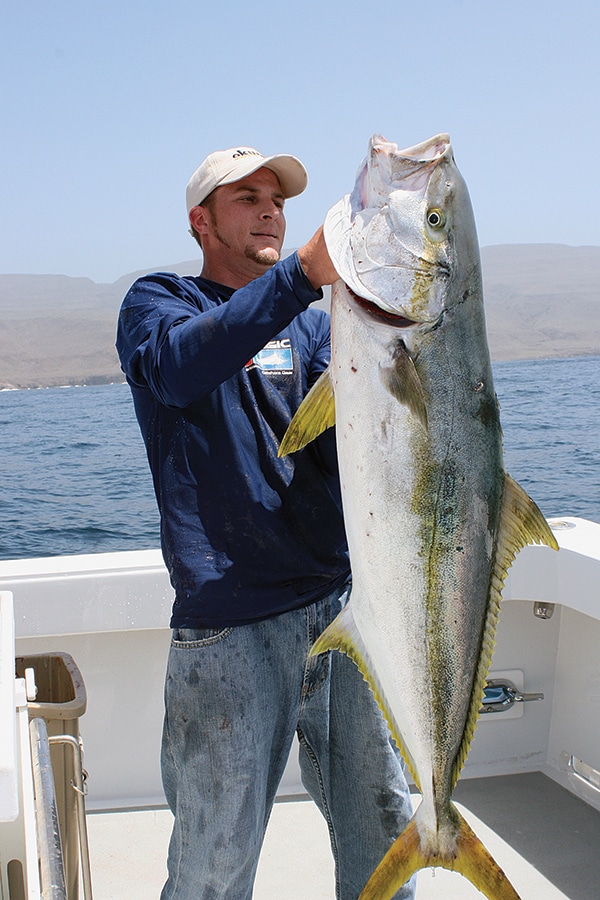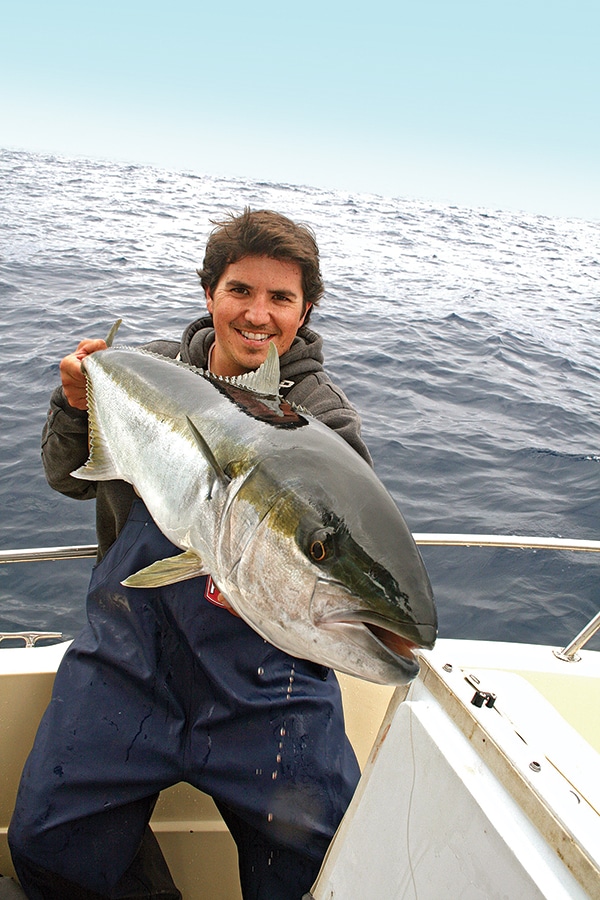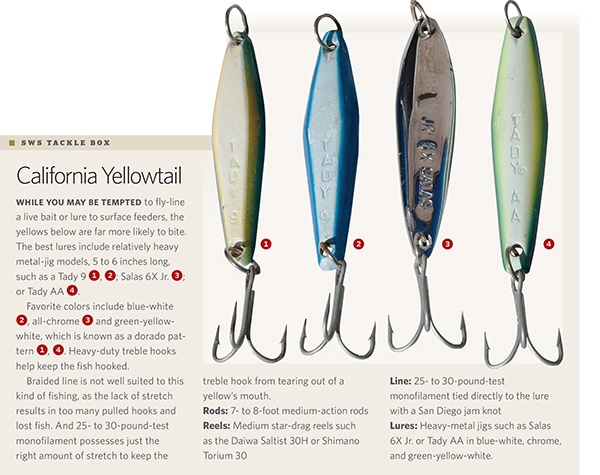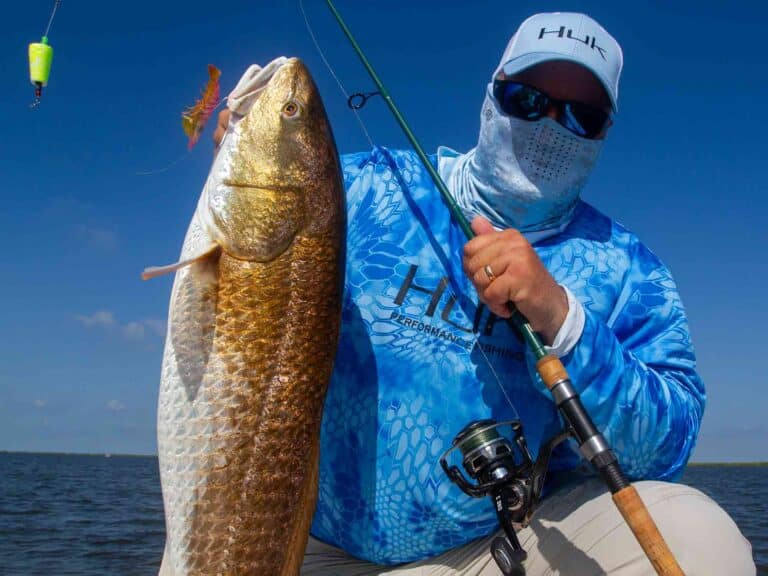The surface of Santa Monica Bay lay as flat as a pancake on this clear and quiet morning in late November. As the autumn sun rose, sea birds began to flitter and swoop, and 50 yards ahead of our boat, a raucous school of California yellowtail exploded in a spray of white water and sardines.
We raced to the scene, slid to a stop and dropped heavy metal jigs below the birds, letting the lures sink 100 feet before putting the reels in gear. All three of us aboard began to wind furiously, and within seconds we all hooked up, rods bent double, arms straining, line melting off the reels, each of us whooping in the delight of a triple on yellows.
Up and Down
This is “yo-yo iron” fishing at its best. Off Southern California in fall, it is often the most effective method for hooking yellowtail — powerful, prized, delicious and beautifully marked members of the amberjack family that reach 30 to 40 pounds along this coast and around the offshore islands.
Yo-yo fishing is so named because you simply drop the jig straight down and reel it back up — like a yo-yo. Surprisingly, it works particularly well when you see yellows feeding at the surface. Most of time it works better than any other method. For reasons not clearly understood, the surface feeders are often less likely to respond to a surface lure or fly-lined live bait, leaving uninformed anglers frustrated and fishless.
Observations of captive yellowtail might offer clues as to why a vertically retrieved jig works well. Once yellows begin feeding, they swim up and down the water column, charging up from below, then returning to depth before rocketing back to the surface to attack again. For anglers who know these secrets, the bite can prove, in the words of young California anglers, “stupid good.”
Bird’s the Word
Wheeling, diving terns**** are the tipoff to rampaging yellowtail, so 7×50 binoculars are helpful to scan for birds. The bite doesn’t always develop at the same time every day, so sometimes you need to hang in an area, anticipating the incoming fish. Some anglers troll deep-diving plugs while scanning the depths with fish finders and looking for feeding birds above the water.
While reading your fish finder, look for schools of bait, and if these have larger fish patrolling underneath, stop and drop a jig. You might have just found yellowtail without the aid of the birds. Don’t dismiss one or two terns flittering high above the water. This indicates the birds have spotted a school of bait being driven to the surface by yellows, and are waiting for them to ascend within striking distance. If the birds are suddenly joined by several others, it’s a sure sign the yellows are poised to erupt.
You also might see the yellowtail themselves, or at least the result of their thunderous feeding behavior. Yellows tear into schools of baitfish from below, then turn and dive, their powerful forked tails pounding the surface to a froth.
Run-and-Gun
If you’re not within casting distance, get on the throttle and run to the fish. Success lies in reaching the action as soon as possible. Don’t worry about spooking the fish. Slide your boat into bird action and drop metal jigs down at least 100 feet, if not to the bottom.
When word on a yellowtail bite gets out, it’s not unusual to have scores of private boaters charging after flocks of diving terns, and some skippers get fixated on the birds, ignoring other boats. Keep safety in mind during run-and-gun fishing to avoid collisions.
Keep It Simple
Working the jig yo-yo style is pretty simple: Point the rod tip down and wind the jig up vertically at a fast clip. Don’t worry about imparting any action or the lure spinning on the way up. Yellows are like house cats — they home in on any fast-moving object and can’t resist pouncing. Retrieve the lure too slowly, and these fish will ignore it.
Many times yellows strike within the first four or five turns of the reel handle. Other times, they might follow the jig all the way to the surface before nailing it. My son, Joshua, hooked his largest yellowtail ever — a 40-pounder — just as he was about to lift the jig from the water. The bruiser ’tail, accompanied by three other fish, followed the lure all the way to the boat before deciding to inhale it. Thus, it’s important to continue your retrieve until the lure is out of the water.
Wind Away
Sometimes yellowtail grab the jig as it descends in what Southern California anglers call “getting bit on the drop.” Whether the strike occurs on the drop or on the retrieve, it’s critical to keep the rod tip pointed at the fish and turn the reel handle as fast as you can.
First, this takes up the stretch in the monofilament line, which can be substantial at 80 to 100 feet. Second, yellowtail often grab prey sideways, so when you get a stop, continue to wind down; this pulls the hooks into the corner of the fish’s mouth. Once you stop getting line — or when the line begins to pour off the spool — you can bring the rod tip up to fight the fish.
A yellowtail’s powerful first run is virtually unstoppable. The good news is that this style of yo-yo fishing takes place in open water, so you can let the yellow burn line without the normal fear of the fish muscling its way into a kelp bed, wreck or reef. On the other hand, multiple hookups demand attentive anglers and close teamwork to prevent cutoffs.
Be cautious as the yellow nears the boat: If the jig rips free under pressure, it becomes a hook-studded projectile. Make sure everyone wears eye protection, such as sunglasses with impact-resistant lenses.
Once the fish is on the gaff, turn on the clicker and flip the reel into free spool. It’s also a good idea to extract the metal jig before letting the fish flop on the deck. This prevents chipping and gouging the boat’s interior, and also keeps the hooks from swinging around and finding an angler’s foot or leg.
Dropping heavy metal jigs down deep when you see fish breaking on the surface might seem counterintuitive, but there’s no denying the effectiveness of fishing yo-yo iron for California yellows













